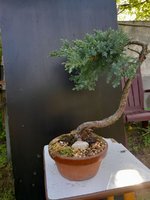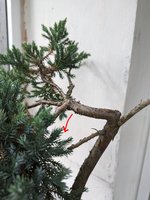Raffia. When I’ve used vet wrap it gets sticky gross and leaves a residue after time. Maybe I used the wrong product or left it on too long.
I’d present a 3rd option. Tom Vuong’s magic wet bending technique. I’ve seen this applied and help applied this at the Huntington on old California Junipers. It bends branches that I wouldn’t not thought possible. To expand on the below, leave some gaps in the electrical tape outside the wet towel so that you can keep it hydrated. You can get an IV drip setup to keep it moist.
Tom Vuong did his magic at the March meeting. He has a great deal of experience bending large branches for his bonsai designs, and we were amazed at how he applied his talents.
He started with an “unbendable”, straight semi-cascade juniper and ended with a heavily transformed tree with beautiful movement in the design. Tom brought two trees; one to show how he prepares for bending and one previously prepared that he bent into his final design. His process to prepare a tree for bending involves wrapping the trunk area to be bent with wet rag paper towels, running two lengths of #4 aluminum wire (one on each side of the bend) and holding it in place with zip ties. He then wraps the area with electrical tape, sticky side out. Tom recommended the wrapped tree be left for one week, keeping the wrapping moist to soften the tree fibers.

sabonsai.org







